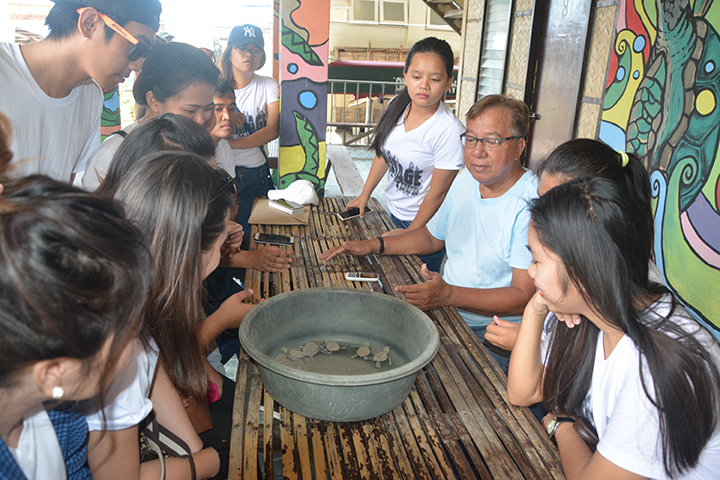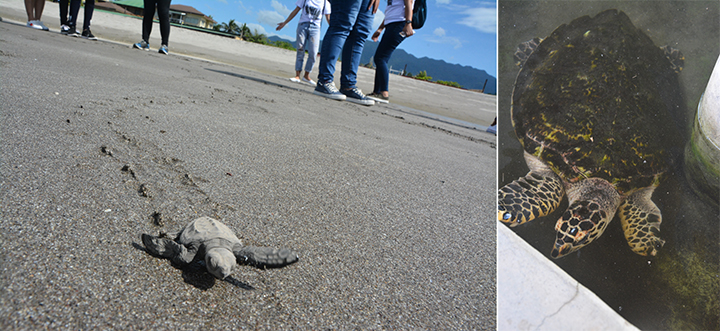In Photo: An olive ridley hatchling struggles to the shore in Barangay Nagbalayong, Morong, Bataan, upon release by visiting tourism students from PLT College on November 15; This rescued injured pawikan is an added attraction in the Pawikan Conservation Center.
‘Marine turtles are important. Why do we need them? Because they help maintain ecological balance. Do you know that marine turtles eat jellyfish? Without marine turtles, there will be plenty of jellyfish, and you cannot swim in the ocean because the jellyfish will get to you and sting you,” a jolly Manolo Ibias told a group of young students on November 15.
Ibias, more popularly known as Mang Manolo, is not a teacher. He is one of the Bantay Pawikan volunteers who run the Pawikan Conservation Center in Barangay Nagbalayong, Morong, Bataan, while the students were from the Learning Links Academy, a school based in Silang, Cavite. They were on a four-day “Bataan Immersion” in Morong, Bataan.

All eyes and ears were fixed on Mang Manolo, the chairman of the group Bantay Pawikan, as he gives lessons that are not normally taught inside the classroom.
Aided by a small projector and graphic illustration of the life cycle of a pawikan, Mang Manolo has been teaching young students visiting their small facility that was established to help save the endangered marine turtles.
Among his “students” that day were some parents who volunteered to join the immersion as they accompanied their children.
Jojie Sastrillo, 48, said the students, as well as their parents, were being taught about the value of marine turtles and why it is important to prevent their extinction.
She said she was happy to see her 11-year-old son, Lance, learn from the activity.
“What did you learn about jellyfish and marine turtles?” she asked Lance.
“Marine turtles are important because they eat jellyfish. Without marine turtles, you cannot swim in the ocean because there will be too many jellyfish in the ocean,” the boy replied.
Asked what he liked about the visit, Lance said: “I like the experience releasing the turtles. We were taught about the common mistakes in releasing turtles. It’s fun!” he said in mixed English and Filipino.
Bantay Pawikan
Teaching young students like Lance is almost a daily routine for the 66-year old Mang Manolo and his crew of 17, mostly senior citizens who operate the Pawikan Conservation Center as part of their sworn duty to protect and conserve the endangered pawikan and their natural habitat.
In Morong, they are known as Bantay Pawikan, the provincial government of Bataan’s first line of defense against all forms of threat against the endangered marine turtles and their habitats, including ocean pollution, destructive fishing, poaching, and harvesting eggs, or simply not caring enough to help rescue injured marine turtles.
As members of Bantay Pawikan, their life’s mission is to prevent the extinction of the endangered marine turtles.
Established in 1999, the Pawikan Conservation Center has become a beacon of hope for the endangered pawikan in Morong, Bataan, the global population of which has dramatically gone down, mainly because of the illegal wildlife trade.
Marine turtles are hunted for their meat, shells, tails, including eggs that are harvested in known nesting grounds, such as in Bataan province.
The Bantay Pawikan was organized by the coastal communities of Morong with the help of by the provincial government of Bataan and the Department of Environment and Natural Resources (DENR) to address the rampant hunting of marine turtles and harvesting of eggs in the coastal communities for the longest time.
Former predators
“Before, we were predators of marine turtles. Now, we are their protectors. We harvested eggs and eat them. That was before the government talked to us and told us to stop doing it because the pawikan population has gone down,” Mang Manolo admits.
The 1,500 square meter Pawikan Conservation Center was then established in 1999, the same year their group was organized. It has a small hatchery, and a lodging house, the income from which fuels the operation of the facility.
“Our job is mainly to guard the marine turtles to prevent poaching. When we see them lay the eggs, we collect the eggs and transfer them to our hatchery,” he said.
Mang Manolo said, that before the Bantay Pawikan was organized, the eggs were harvested and sold secretly at P3 to P4 each.
Today, he said some “hardheaded” poachers harvest eggs when the Bantay are not around, and sell three eggs for P20.
Through the facility, which is frequented by students from various schools in the country, the members of Bantay Pawikan help send the message across about the serious threats to, and vulnerabilities that can lead to the extinction of these amazing creatures of the sea.
“Teaching them on-site, with real pawikan or even colorful photos, is effective. It is always better to start teaching about the importance of wildlife while they are still young,” Mang Manolo said, noting that the Center’s visitors are sometimes students in high school and college, who, unlike the younger ones, are not always able to absorb the all-important lessons.
On the same day, when students of Learning Links Academy visited the Pawikan Conservation Center, some tourism students of the PLT College based in Nueva Vizcaya were there to learn from Mang Manolo and his fellow Bantay Pawikan.
Some of them were given the opportunity to release a few of the newly hatched olive ridley turtles.
Together with those released by the Learning Links Academy students on the eve of November 14, a total of 42 olive ridley hatchlings were released. As of November 15, there were 40 nests in the hatchery.
“That is about 4,000 eggs. But in one season we get to secure 200,000 eggs,” Mang Manolo said.
He said about 73 percent of the eggs are hatched and released back to the ocean.
“Owing to the many threats, it was assessed that only 1 percent or even less will survive and, hopefully, return here to lay eggs,” he said.
That is the reason, he explained, marine turtles are highly vulnerable and can become extinct if not cared for.
Migratory turtles
Five of the known seven highly migratory marine turtles are known to visit the Philippines, which hosts a number of important nesting sites, such as the Turtle Islands in Tawi-Tawi province, the biggest marine turtle sanctuary in Southeast Asia, and the province of Bataan, which hosts several nesting grounds, including sanctuaries or hatcheries where the eggs are transferred and secured.
Sometimes, turtle eggs are reported and transferred to the hatcheries with the help of “enlightened” members of coastal communities, which were attributed to the effective awareness campaign of the DENR, the provincial government, and various local government units (LGUs) of Bataan, said Edgar D. Laggui, Community Environment and Natural Resource Officer (Cenro) in Bagac.
Volunteerism
Laggui told the BusinessMirror in an interview on November 15 that volunteerism is key to protecting the coastal and marine environment, including threatened species.
“Our volunteers here in Pawikan Conservation Center do not receive a salary. They only get allowances. They patrol the coastal areas and help protect the marine turtles,” he said.
There are five marine turtle hatcheries in Bataan. Besides the hatchery inside the Pawikan Conservation Center in Morong, there are three more in Mariveles, Bataan and one in Bagac, which is being managed by Montemar Beach Resort in Bagac.
Adela M. Lunca, of Cenro Bagac Park Maintenance who is also detailed in the DENR-Bataan’s Biodiversity Management Sector, added that because of the strong collaboration between the DENR, the provincial government, Morong-LGU and the communities, the trading of turtle eggs has stopped in Morong.
“Now, even the communities are turning over the eggs they discover. They are now fully aware of the importance of those eggs,” she said.
Pawikan Festival
The strong commitment of the provincial government in protecting and conserving marine turtles is demonstrated by the holding of the Pawikan Festival every December 1 and 2.
In a telephone interview on November 14, Raul Mamac, Bataan Provincial Environment and Natural Resource officer, said the Center is a nesting site of marine turtles.
During the festival, people from all over Bataan, including visitors from other provinces, congregate in the area to join the festivities.
The DENR, he said, has partnered with the provincial government to ensure the protection and conservation of Bataan’s mangrove forests.
“We have around a 10 kilometer stretch of thick mangrove forest from Organi to Samal and Abucay, including our wetland [in Bagac],” he added.
Mamac underscored the importance of maintaining the health of the coastal and marine environment, as well as its forests, to the people in the province, who continue to rely on the terrestrial and coastal resources.
‘1M 4 1B’ program
Demonstrating Bataan’s pro-environment stance, he said various stakeholders are being rallied behind the “1M 4 1B” program, which stands for “1 million trees for 1 Bataan Challenge,” a massive tree-planting program, “conceptualized to empower environmental responsiveness through crowdsourcing to encourage everyone to take action in this responsibility.”
Protecting and conserving the marine turtles is part of the Integrated Coastal Management (ICM) of Bataan province, said Engr. Victor Ubaldo, the Provincial Government Environment and Natural Resources Office chief of Bataan. The ICM in Bataan was strengthened by the partnership of the provincial government, the DENR and the Partnerships in Environmental Management for the Seas of East Asia (Pemsea).
“As much as possible, because of industrialization, we try to strike a balance between economic growth and protecting the environment, particularly our coastal areas,” Ubaldo said.
Bataan is at the forefront of the country’s socioeconomic growth boasting of a robust agriculture fishery, and manufacturing sectors, according to the official web site of Pemsea.
Among the ongoing ICM activities in Bataan are coastal strategy development, beach clean-ups, public-awareness campaigns, mangrove rehabilitation and fish/turtle sanctuary establishment.
“If you will notice, here in Bataan, we have several seaports. We also have some private seaports. But as much as possible, we try to conserve our mangrove forests and we also do rehabilitation,” Ubaldo added.
Incidentally, Pemsea will showcase ICM sites in the Philippines as it plays host to the East Asian Seas (EAS) Congress 2018 from November 27 to 30 in Iloilo City.
Bataan, Ubaldo said, will be sending two delegations—one for the Congress and another delegation for the Fifth EAS Youth Forum, which will be held parallel to the EAS Congress 2018.
Published in Business Mirror.

